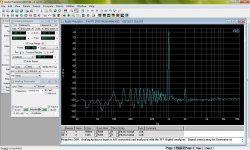Hi folks, my friend bought a power amp from a small manufacturer locally, it's single ended, non-feedback, discrete stuff, two big toroidal trannies inside (450W each), diamond output stage, using 6 pair of 2SC5200/2SA1943, output power is about 100w @ 8ohm, here's the FFT result they send us, gosh, there're lot of distortion between 90 - 900Hz compared with 1k - 20kHz (but, there's still a peak at 2kHz), what reasons do you guys think that may course these distortion? How do we tweak it to make it lower distorted in those area?


PSU noise? Maybe, hard to solve it I guess.
I don't think you want to 'solve' it. This is one hell of an amp.
This is very low level rectifier residual. Very, very good amp!
Jan
How do we tweak it to make it lower distorted in those area?
Either you improve the electronics' PSRR (tricky if you don't understand the circuit) or you improve the output ripple of the power supply. You can do the latter by adding an LC filter on the output of what you already have, PSU-wise.
some make the distinction between hum and buzz
hum is the mains frequency
buzz is the rectified integer harmonic spray starting at 2x
both can be coupled magnetically
but common impedance coupling with rectified current spikes causing V drop in PS ground return that is common with signal ground reference is anther place to look internally especially with Buzz
Hum can be from chassis leakage current common impedance coupling - a different set of locations and wiring detail to check
hum is the mains frequency
buzz is the rectified integer harmonic spray starting at 2x
both can be coupled magnetically
but common impedance coupling with rectified current spikes causing V drop in PS ground return that is common with signal ground reference is anther place to look internally especially with Buzz
Hum can be from chassis leakage current common impedance coupling - a different set of locations and wiring detail to check
depending on the test level, yes it could be pretty good
really need to look at the whole system, speaker sensitivity, room noise, placement/listening position
It appears from the figure data, that the output is about 1V for this measurement. The P.S. noise level is 100dB down from 1v. Each 20db is a factor of 10 so the noise level is 1v*10 to the power -5, or 10uv. Maybe with high sensitivity headphones and anechoic room someone with perfect hearing could detect hum. With any conceivable loudspeaker you won't hear any noise. If the designer has done this well, then I'd guess that any audible noise would be system grounding practices not the amp. If these measurements are representative, then any attempt at modification is far far more likely to degrade performance than to improve the measurement.
By the way, the measured harmonic distortion is only 2nd harmonic (the peak at 2k, and very low. In fact, Jan is conservative in his comments. It measures astonishingly well.
Sheldon
Last edited:
By the way, the measured harmonic distortion is only 2nd harmonic (the peak at 2k, and very low. In fact, Jan is conservative in his comments. It measures astonishingly well.
Sheldon
Agreed. But there is something fishy here. Read again post 1. SE, no feedback, and then this? Someone tries to pull our collective leg.
Jan
Agreed. But there is something fishy here. Read again post 1. SE, no feedback, and then this? Someone tries to pull our collective leg.
Jan
Quite possible. I almost ended my last post with: Too good to be true?
Given the thread starter's apparent state of understanding, I didn't place much credence in the initial description. A diamond buffer certainly isn't single ended, so not sure what it even means in this context. A little more clever troll, perhaps?
Sheldon
Last edited:
Can you get us a circuit diagram?
Lol I wish I have that skill... here's the amp my friend picked up, it's discontinued: audio-gd Precision product
Lol I wish I have that skill... here's the amp my friend picked up, it's discontinued: audio-gd* Precision product
Looks pretty nice! I can only say again, the measurement on the THD is very very good, don't 'improve' anything!
Jan
Excuse me for the side question. Are the Chinese amps this good now a days. I read quite a few that they are no joke. My friend own a Jolida and he swear by it.
I was entertained reading this thread until I looked at the picture in the link, that's a serious looking amp with separate power transformer.
the graph is from manufacturer, it'll be nice to see a real measurement in this forum.
I don't see the website stated it's single end nor even class A. Am I missing something? It's just kept saying ACSS. What's that?
I was entertained reading this thread until I looked at the picture in the link, that's a serious looking amp with separate power transformer.
the graph is from manufacturer, it'll be nice to see a real measurement in this forum.
I don't see the website stated it's single end nor even class A. Am I missing something? It's just kept saying ACSS. What's that?
Last edited:
Here's a more detailed description of some of the design topology:
audio-gd* Precision product
http://www.audio-gd.com/Pro/amp/Precision2/Precision2EN_Tech.htm
Sheldon
audio-gd* Precision product
http://www.audio-gd.com/Pro/amp/Precision2/Precision2EN_Tech.htm
Sheldon
- Status
- This old topic is closed. If you want to reopen this topic, contact a moderator using the "Report Post" button.
- Home
- Amplifiers
- Solid State
- How to improve the distortion of this amp?